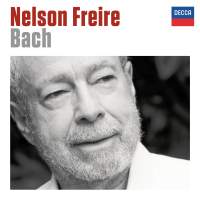Texte paru dans: / Appeared in: |
|
|
Outil de traduction ~ (Très approximatif) |
|
|
Reviewer: Alex
McGehee What would cause a true virtuoso of the piano, in the autumn of his long career, to step outside the 19th-century repertoire for which he has established his formidable reputation and record the works of a composer with whom he has never been associated? In keeping with the reclusive nature and well-known modesty of Nelson Freire, the answer would probably be to let the music he plays speak for itself. And the way Freire plays this music says a lot. Bach’s Partita No. 4, his English Suite No. 3, the Toccata in C Minor, BWV 911, and the Chromatic Fantasy and Fugue form the backbone of this recital. The other selections are transcriptions of Bach’s organ and vocal works, and include one transcription by the composer himself, the Adagio from Alessandro Marcello’s Oboe Concerto in D Minor. What becomes almost immediately apparent in listening to this recording is the Brazilian pianist’s musicianship. He clearly places this above technique, which he already has in spades. Every line is delineated and balanced in relation to the work’s other voices. Of course the ability to achieve this is a primary reason not to ban Bach’s keyboard works from the piano. The bel canto style, with which Freire has long been associated, is said to be a hallmark of the 19th century’s greatest pianists. Of course, without listenable recordings or living eyewitnesses, we have no way of proving this. All that remains is the written word from critics of that age. But consider Freire’s interpretation of the organ Prelude in G Minor, BWV 535, as transcribed by Alexander Siloti, Rachmaninoff’s teacher and Liszt’s student. The performance is so over the top that something quite grandiose must have been going on during those days. Freire plays this transcription in the style in which it was written—one-half Bach and the rest Siloti. There is the requisite Busoni transcription here too, Ich ruf zu dir, Herr Jesu Christ, BWV 639. But it is the now hackneyed work, as transcribed in the 1920s by the British pianist Myra Hess, Jesu, Joy of Man’s Desiring (from Bach’s Cantata No. 147), that ultimately proves the transformative nature of Nelson Freire’s art. He ends this recording by lifting this choral work out of its well-worn rut and convincing you that improved and changed, you are listening to one of the greatest compositions ever written for the piano. | |
|
|
|
|
Cliquez l'un ou l'autre
bouton pour découvrir bien d'autres critiques de CD |
|




